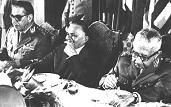OBS: Quanto ao preço...
Lockheed will next month release an updated estimate of the plane's cost, and executives said it would be in the $US45 million to $US65 million range in 2002 dollars, with the Australian variant on the low end of the range. Air Vice-Marshal Harvey said the $US112 million price tag reported in the US included development costs, spares, equipment, support and facilities.
http://www.theaustralian.news.com.au/st ... 77,00.html
$9bn bonanza in F-35 deal
* The fighter program will bring lucrative contracts to the local aerospace industry, writes Steve Creedy
* March 23, 2007
THE Australian aerospace industry stands to reap about $9 billion from its involvement in the F-35 Joint Strike Fighter program over the next three decades, according to the plane's US developer, Lockheed Martin.
Lockheed F-35 program manager Abhay Paranjape said Australian companies were already earmarked to receive work worth about $5 billion, provided they continued to provide best-value solutions for the project. This did not include work on the fighter's engines, and included no multiplier effect.
The US defence firm has moved from the traditional model of industrial offsets for plane orders to a system of competition between countries for the work on a global basis.
"The US and the other seven participant countries together are planning to procure more than 3000 aircraft," Mr Paranjape said at the Australian International Airshow this week.
"This is a best-value procurement program and it's not based on offsets, so Australia will be able to compete for that volume."
Mr Paranjape said Lockheed had laid out a plan defining when it would start procuring components, how many it would need and the estimated value of the work. He said $9 billion was a rounded total number of all the opportunities and values available to Australia.
Australian companies had already won contracts worth $100 million in the system development and demonstration phase of the program, he said.
Those developmental contracts were worth another $1.6 billion over the 3000 aircraft, as Lockheed began to gear up for production. "So you have $1.7 billion that is in hand if the companies continue to perform and they continue to provide the best value that they've proven they can right now."
The Lockheed executive said there were also strategic second sources that would not be subject to competition and had been selected based on the capabilities of Australian companies.
"For example, we're going to manufacture 700 vertical tails in Australia," he said. "That's an approved project in Australia. As long as Hawker de Havilland performs to our standards of quality and schedule and cost, we intend to manufacture those here.
"So, you take the strategic second sourcing opportunities and the existing work in hand, you add that together and that's $5 billion. In addition to that, there's about $4 billion in open competitions around the world targeted towards companies that already have a capability."
Mr Paranjape has been working with Australian companies for the past four or five years. He said he had been impressed by their innovation and the capabilities of the country's small-to-medium enterprises. "Australia does not have a market as large as the US or Europe," he said.
"These companies have learned not just to survive but to thrive in a small market that is export-oriented.
"They have learned how to deal with US companies or with European companies and be competitive. An example I will give is that I was stunned when I saw companies here in Australia providing machine parts and components to China.
"You see how much the Chinese are manufacturing around the world right now, but when it comes to some hi-tech machining and being competitive, there are Australian companies providing parts to companies in China."
Responding to criticism that Australian companies were not getting enough from the JSF program, Mr Paranjape agreed this was partly due to the fact that production phase had not yet kicked in.
"The other thing is, this is not offset," he said. "It is best-value competition. If I lose the competition I am going to be critical."
Lockheed F-35 program executive vice-president Tom Burbage said the aircraft's flight testing was on track after the inaugural flight in December. The aircraft was performing extremely well.
Australia plans to spend $11.5 billion buying up to 100 conventional take-off and landing F-35s and in December signed an undertaking to participate in the production, sustainment and follow-on development phase. It is due to commit to buying aircraft in 2008.
A Government Audit Office report on the program prompted reports of a cost blowout, but Air Vice-Marshal John Harvey, the RAAF's program manager for new air combat capability, said the report was "consistent with prices we have been discussing in the past".
Lockheed will next month release an updated estimate of the plane's cost, and executives said it would be in the $US45 million to $US65 million range in 2002 dollars, with the Australian variant on the low end of the range. Air Vice-Marshal Harvey said the $US112 million price tag reported in the US included development costs, spares, equipment, support and facilities.
"If you take all those factors out and get back to an average unit fly-away costs for the CTOL variant, which we will be buying, it gets down to about $47 million in US 2002 dollars," he said. That was consistent with reports over a long time.
The JSF remained the right choice for Australia's future air combat requirements because it represented the optimal mix of capability and cost, he said.
Alternatives to the JSF, such as extending the life of the F-111, did not make such a solid business case and the only other fifth generation fighter, the F-22 Raptor, could not perform the range of tasks required by Australia, he said.
The JSF could carry a wider range of weapons, bigger weapons and had a wider array of sensors than the F-22A. "The F-22A also comes at about twice the cost of JSF," he said.
Australia expects to acquire the first aircraft in 2013 and should have the first squadron ready for deployment in 2015, with full capability in 2018.









